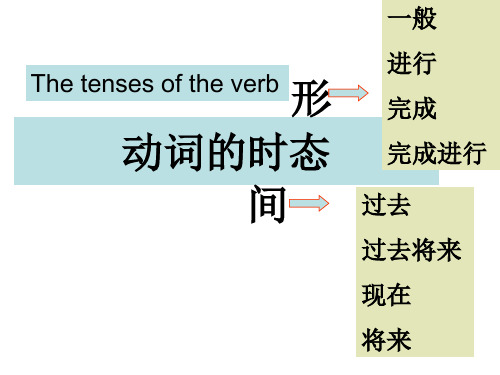初中英语语法动词时态讲解ppt课件
合集下载
初中英语七种时态 初中英语语法 教学PPT课件

1.改为一般疑问句并回答。 Are you doing your homework now? Yes, I am./No, I'm not. 2.改为否定句。
I am not doing my homework now.
五、过去进行时 1.过去进行时:表示在过去某一时刻或某一阶
段正在进行的动作。
2.常用时间状语: at that time, at 8:00 last
4)表示客观真理,客观存在,自然现象。 例如:The earth moves around the sun.
地球绕太阳转动。
I do my homework every day.
1.改为一般疑问句并回答。 Do you do your homework every day? Yes, I do./No, I don't. 2.改为否定句。
2.过去进行时的用法:
表示在过去某时刻正在进行或发生的动作,通常与表 示过去的时间壮语连用。
例如:At this moment yesterday, I was packing for camp. 昨天这个时候间壮语从句的复合句中,表示一个过去的 动作发生时或发生之后,另一个动作正在进行。
close
sit begin run put
lie die tie
-ing形式
listening spending staying
having preparing
closing
sitting beginning running
putting
lying dying tying
I am doing my homework now.
like live
plan stop drop
I am not doing my homework now.
五、过去进行时 1.过去进行时:表示在过去某一时刻或某一阶
段正在进行的动作。
2.常用时间状语: at that time, at 8:00 last
4)表示客观真理,客观存在,自然现象。 例如:The earth moves around the sun.
地球绕太阳转动。
I do my homework every day.
1.改为一般疑问句并回答。 Do you do your homework every day? Yes, I do./No, I don't. 2.改为否定句。
2.过去进行时的用法:
表示在过去某时刻正在进行或发生的动作,通常与表 示过去的时间壮语连用。
例如:At this moment yesterday, I was packing for camp. 昨天这个时候间壮语从句的复合句中,表示一个过去的 动作发生时或发生之后,另一个动作正在进行。
close
sit begin run put
lie die tie
-ing形式
listening spending staying
having preparing
closing
sitting beginning running
putting
lying dying tying
I am doing my homework now.
like live
plan stop drop
初中英语中考复习时态讲解课件(共79张ppt)

一般现在时
1. 表示经常性或习惯性的动作
She does excersice everyday.
真题链接
—What do you often do at weekends?
—I often ____ my grandparents.
A. visit
B. visited
C. have visited D. will visit
Just a moment, I am washing dishes.
when
习题
Just a minute! My brother________ his car in the garden. A. washes B. is washing C. washed D. will wash
习题
---Hey, Tom. Let’s go swimming.
动词过去分词 不规则变化
speak hear see give build swim buy teach
spoken heard seen given built swum bought taught
现在完成时
already yet
1.过去发生或已完成的某一动作对现在的影响。
I have already watched this film. I haven't watched this film yet. I have already visited America. I haven't visited America yet.
A. prepares
B. is preparing
C. has prepared D. prepared
真题链接
--Mum, it's late. Why are you still here? --Dad hasn't come back yet. I ____ for him. A. am waitingB. was waiting C. waited D. had waited
初中英语动词的时态和被动语态(共14张PPT)

延续性动词 be on be at/in+地点 be at/in+地点 be in/a member of be on have know keep
have a cold
have been to—have gone to
曾经去过(主语人在) 已经去了(主语人不在)
--I can’t find you these days.Where have you been?
be over be up be back be away (from) be here /there
非延续性动词 put on come/go to arrive/reach/get to join begin/start buy get to know borrow / lend
catch a cold
定义 表示过去某时间或某动作以前发生的动作。
结构 关健字
S+had+V过去分词
IwSr+heheaanlidzIner’det+aIVchh过ae去dd分let词hftemcoyupHnutar.sde+Sa+t Vh过om去分e词
by the time I came back,by the end of last term, when I got to the station,before he went to bed
表示过去某时刻或某阶段正在发生的动作。
was
1.SW+hawtawsna’st /hwe edroein’gt dwohinegn the UFO arrived?
结构 S+ weredoing 2W. Tahse/yWweerree+hSav+idnoginfugn…th?ese days.
初中英语语法—时态(28张) PPT课件 图文

(4)现在完成时与表示一段时间的for短语、since短语或从句等 时,应注意句中的谓语动词须是延续性的,而不能是非延续性动词,如 come→be here,go→be there,die→be dead,borrow→keep,buy→h ,join→be in,leave→be away,begin to study→study等。
6.过去进行时
(1)概念:表示过去某一时刻或某一时间段内正在进行的动作。 (2)构成形式:was/were+动词的-ing形式 ①表示往返、位移的动词的过去进行时常可用来表示过去将来时
时态 We wanted to tell her that the train was_leaving an hour later.
1.一般现在时
基本用法: (1)表示经常性、习惯性的动作; He always helps others. 他总是帮助别人。
时态 (2)表示现在的情况或状态;
He is a teacher. 他是个老师。 (3)表示客观事实和普遍真理。 The sun rises in the east. 太阳从东边升起。 构成形式:am/is/are或实义动词的原形(主语是第三人称单数时,动 词要用第三人称单数形式)。
时态 (2)构成形式:have/has+动词的过去分词。
(3)与现在完成时连用的时间状语有for a long time,recently,yet, lately,ever,never,already,since,by this time,before,just,in t past/last few years,since+过去的时间点,since+时间段+ago,since +从句(一般过去时)。
表示感觉的动词。如:see,hear等。 表示喜欢或厌恶的动词。如:like,love等。 表示希望的动词。如:want,would like等。
初中英语语法课件ppt

vacation together.
过去将来时的使用:
一、过去将来时表示对于过去某一时间而言将要发生的动 作或存在的状态。 would或was /were going to + V
would可用于各种人称。
二、would +V还可表示过去的习惯动作,在这点上同used to同义。
When we were children, we would/used to go swimming every summer.
e) 用于条件从句“如果……想,设想”(接近if ……want to,或 if ……should) 例:Greater efforts to increase agricultural production must be made if food shortage ____________ avoided. A) is to be B) can be C) will be D) has been
一般现在时的动词形式: 动词原形 1.am;is ;are 2.have,has 3.第三人称单数形式-(e)s
肯定句:I watch television every day.
否定句:I don’t watch television every day.
疑问句:Do you watch television every day.
一般现在时的使用:
1.一般现在时表示总是、通常、习惯 性的动作或状态。
It snows in winter. I watch television every day.
2.用于对客观事实的普遍性的陈述。
Water consists of hydrogen and oxygen. Most animals kill only for food. The world is round.
过去将来时的使用:
一、过去将来时表示对于过去某一时间而言将要发生的动 作或存在的状态。 would或was /were going to + V
would可用于各种人称。
二、would +V还可表示过去的习惯动作,在这点上同used to同义。
When we were children, we would/used to go swimming every summer.
e) 用于条件从句“如果……想,设想”(接近if ……want to,或 if ……should) 例:Greater efforts to increase agricultural production must be made if food shortage ____________ avoided. A) is to be B) can be C) will be D) has been
一般现在时的动词形式: 动词原形 1.am;is ;are 2.have,has 3.第三人称单数形式-(e)s
肯定句:I watch television every day.
否定句:I don’t watch television every day.
疑问句:Do you watch television every day.
一般现在时的使用:
1.一般现在时表示总是、通常、习惯 性的动作或状态。
It snows in winter. I watch television every day.
2.用于对客观事实的普遍性的陈述。
Water consists of hydrogen and oxygen. Most animals kill only for food. The world is round.
动词的时态和语态-PPT课件

8. The man _h_a_d__h_o_p_e_d__ (hope) to catch the last train, but he was too late.
9. The boys __w_e_r_e_p_l_a_y_in_g___ (play) basketball from 5:00 to 6:00 yesterday.Βιβλιοθήκη .19练习
.
20
用所给动词的正确形式填空: 1. She _l_e_ft__ (leave) the office two
hours ago. 2. As son as she arrived home, the girl
discovered that she _h_a_d__t_a_k_e_n__ (take) her friends book by mistake. 3. Who _c_o_m__e_s__ (come) to school earliest in your class every morning? 4. Great changes _h_a_v_e_t_a_k_e_n_p__la_c_e__ (take place) in this city since 1979. 5. By the time he was twelve, Edison _h_a_d__b_e_g_u_n_ (begin.) to sell newspape21rs.
I’ll go to see you when I have time. I’ll go to see you if I have time tomorrow. 2. 某些动词,如:stand, continue, wish, love, like, hate, feel, find, think等常用一般现在时态
9. The boys __w_e_r_e_p_l_a_y_in_g___ (play) basketball from 5:00 to 6:00 yesterday.Βιβλιοθήκη .19练习
.
20
用所给动词的正确形式填空: 1. She _l_e_ft__ (leave) the office two
hours ago. 2. As son as she arrived home, the girl
discovered that she _h_a_d__t_a_k_e_n__ (take) her friends book by mistake. 3. Who _c_o_m__e_s__ (come) to school earliest in your class every morning? 4. Great changes _h_a_v_e_t_a_k_e_n_p__la_c_e__ (take place) in this city since 1979. 5. By the time he was twelve, Edison _h_a_d__b_e_g_u_n_ (begin.) to sell newspape21rs.
I’ll go to see you when I have time. I’ll go to see you if I have time tomorrow. 2. 某些动词,如:stand, continue, wish, love, like, hate, feel, find, think等常用一般现在时态
初中英语语法动词时态讲解ppt课件

8. Sam _li_v_e_d( live) in the small town for five years
during the war.
have grown
9. It is ages since I last _s_a_w_(see) you. You ___(grow)
taller.
10. He won’t tell us where he __g_o_t__(get) the book.
(2) 现在进行时 • 表示说话时正在进行的动作.
e.g. He is walking towards the plane. 2. 表示目前一阶段正在进行(但说话时不一定在进
行)的动作: e.g. We are writing a paper these days.
一般现在时与现在进行时的区别 寒假来临,不少的高中毕业生和大学在校生都选择去打工。准备过一个充实而有意义的寒假。但是,目前社会上寒假招工的陷阱很多 • 进行时强调动作正在进行,而现在时强调动作的
经常和反复,或特征,这类动作没有时间性的. • 某些表示感官知觉的动词如: see, hear, smell,
taste等表示感觉,用一般时,不用进行时.
e.g. Do you see a plane in the sky? 注意:1) feel 可以用一般时和进行时表示说话时 的感觉:
e.g. I am not feeling well today.
We were having a discussion at that time. 2. 表示过去某一阶段正在进行的动作.
寒假来临,不少的高中毕业生和大学 在校生 都选择 去打工 。准备 过一个 充实而 有意义 的寒假 。但是 ,目前 社示过去某一时刻正在进行的动作.
初中英语语法—时态课件(28张)

①一般在动词后直接加ed。如:climbed,worked,asked等。
②以e结尾的动词在后面直接加d。如:lived,described,agreed等。 ③以辅音字母+y结尾的,先把y变为i再加ed。如:cry—cried, copy—copied,try—tried等。以元音字母+y结尾的,直接加ed。如 enjoy—enjoyed,play—played等。
1.一般现在时
基本用法: (1)表示经常性、习惯性的动作; He always helps others. 他总是帮助别人。
时态 (2)表示现在的情况或状态;
He is a teacher. 他是个老师。 (3)表示客观事实和普遍真理。 The sun rises in the east. 太阳从东边升起。 构成形式:am/is/are或实义动词的原形(主语是第三人称单数时,动 词要用第三人称单数形式)。
①表示有礼貌地询问对方是否愿意或表示客气的邀请或命令时。
Will you please lend me your pen? 请把你的钢笔借我用一下,好吗? ②表示意愿时。
We will help him if he asks us. 如果他愿意,我们会帮助他。 ③表单纯性的将来,与人的主观愿望和判断无关时。 The sun will set at 7:30 this afternoon.
MidAutumn Day usually comes in September or October every year. 中秋节通常都在每年的九月或十月。
考查热点:如果主句为一般将来时,if,unless等引导的条件状语从句和
时态 when,until,as soon as等引导的时间状语从句常用一般现在时表示将来。 What about going climbing if it doesn't rain tomorrow? 如果明天不下雨,去爬山怎么样?
②以e结尾的动词在后面直接加d。如:lived,described,agreed等。 ③以辅音字母+y结尾的,先把y变为i再加ed。如:cry—cried, copy—copied,try—tried等。以元音字母+y结尾的,直接加ed。如 enjoy—enjoyed,play—played等。
1.一般现在时
基本用法: (1)表示经常性、习惯性的动作; He always helps others. 他总是帮助别人。
时态 (2)表示现在的情况或状态;
He is a teacher. 他是个老师。 (3)表示客观事实和普遍真理。 The sun rises in the east. 太阳从东边升起。 构成形式:am/is/are或实义动词的原形(主语是第三人称单数时,动 词要用第三人称单数形式)。
①表示有礼貌地询问对方是否愿意或表示客气的邀请或命令时。
Will you please lend me your pen? 请把你的钢笔借我用一下,好吗? ②表示意愿时。
We will help him if he asks us. 如果他愿意,我们会帮助他。 ③表单纯性的将来,与人的主观愿望和判断无关时。 The sun will set at 7:30 this afternoon.
MidAutumn Day usually comes in September or October every year. 中秋节通常都在每年的九月或十月。
考查热点:如果主句为一般将来时,if,unless等引导的条件状语从句和
时态 when,until,as soon as等引导的时间状语从句常用一般现在时表示将来。 What about going climbing if it doesn't rain tomorrow? 如果明天不下雨,去爬山怎么样?
初中英语语法时态(共25张PPT)

A.goes B.will go
C.would go D.are going
2.--Did your son fail his English exam once again?
--Yes, but he told me he____hard next term.
A.studies B.is studying C.will studyD.would study
2 have been to+地点,表示“去过某
地”。(人已回) I have been to Europe. (I am not in Europe now.)
3 have been in+地点+时间段,表示“在/ 来某地多久”。
I have been in Europe for three weeks. (I am now still in Europe .)
3.现在完成时和一般过去时的异同点: 1 共同点:动作都在过去。 2 不同点:和现在有无关系。(与现
在有关的过去动作用现在完成,与现在 无关的过去动作用一般过去。)
4.易错点:
1 have gone to+地点,表示“去了某地”。
(人已走,尚未回。只用于第三人称。)
They have gone to Europe. (They are not here.)
C.didn’t he
D.did he
三、现在进行时
1.用法:
A.现刻动作:目前正在发生的动作。
B.现阶段动作:目前一个时期一直在进 行的动作,此刻不一定在进行。
2.标志词:now,Look! Listen!
中考模拟:
--Mike, who____football in the yard?
英语八大时态PPT课件(详细版)

时态
A
知识导航
种类
一般现在时 一般过去时 一般将来时 现在进行时 现在完成时 过去进行时 过去完成时 过去将来时
构成
do/does did will/shall+动词原形 am/is/are + doing have/has+过去分词 was/were + doing had+过去分词 would/should+动词原 形
A
4
※表示主语所具有的特征、性格、 能力、状态等
She is a middle school student. She looks a little worried. ※某些以here/there开头的句子 中,用一般现在时表正发生的动 作
Here comes the bus.
A
5
※表示将来发生的、时刻表上不改变的事 The train leaves Hunan at five o’clock. ※特殊情况 在时间状语从句和条件状语从句中,若主 句用一般将来时,则从句用一般现在代替 将来。(主将从现)
A
21
四、一般将来时
1、构成 一般将来时态由
“will/shall+动词原形”构成,me to ask Mary for help.
A
22
2、其他表示
※be going to +动词原形:表示 说话人主观的打算或预测。 I am going to look for a job here. It is going to be a fine day for camping tomorrow.
【小试牛刀】 他们昨天这个时候正在吃晚餐。
They were having dinner this time yesterday.
A
知识导航
种类
一般现在时 一般过去时 一般将来时 现在进行时 现在完成时 过去进行时 过去完成时 过去将来时
构成
do/does did will/shall+动词原形 am/is/are + doing have/has+过去分词 was/were + doing had+过去分词 would/should+动词原 形
A
4
※表示主语所具有的特征、性格、 能力、状态等
She is a middle school student. She looks a little worried. ※某些以here/there开头的句子 中,用一般现在时表正发生的动 作
Here comes the bus.
A
5
※表示将来发生的、时刻表上不改变的事 The train leaves Hunan at five o’clock. ※特殊情况 在时间状语从句和条件状语从句中,若主 句用一般将来时,则从句用一般现在代替 将来。(主将从现)
A
21
四、一般将来时
1、构成 一般将来时态由
“will/shall+动词原形”构成,me to ask Mary for help.
A
22
2、其他表示
※be going to +动词原形:表示 说话人主观的打算或预测。 I am going to look for a job here. It is going to be a fine day for camping tomorrow.
【小试牛刀】 他们昨天这个时候正在吃晚餐。
They were having dinner this time yesterday.
初中英语动词时态讲解 (共37张PPT)

2.
系动词只和形容词连用,构成系表结构
1) 2) 3)
实义动词
1. 2.
3.
实义动词指的是有具体行为意思的动词。 实义动词在句中可以做谓语动词和非谓语 动词。 做谓语动词的用法 动词会有四种形式:单三,现在分词,过 去式,过去分词
实义动词
注意:掌握四种形式的变化规律 1) He works in the office. 2) We are dancing together. 3) I caught a cold last week. 4) She has watered the flower.
want to do decide to do plan to do would like to do learn to do tell sb.( not)to do ask sb.(not) to do
实义动词
注意下列词不同形式的不同用法: 注意下列词不同形式的不同用法: remember doing/to do forget doing/to do stop doing/to do go on doing/to do
实义动词
4.
做非谓语动词的用法(指出现在谓语动词 之后的动词,它受前面谓语动词的限制) 动词会有三种形式:
1) 2) 3)
原型(do) 原型(do) 动名词(doing) 动名词(doing) 不定式(to 不定式(to do)
实义动词
1)
用原型:
a) b) c) d)
let sb.do make sb.do help sb.(to)do had better do
一般将来时
一般将来时表示将来发生的动作或存在的状态 结构: 助动词shall/will + 动词原形(shall一般用 助动词shall/will 动词原形(shall一般用 于主语是第一人称时, Will是英语任何主语。) Will是英语任何主语。) 肯定式:主语+shall/will+动词原形+ 肯定式:主语+shall/will+动词原形+其他 否定式:主语+shall/will+not+动词原形+其他. 否定式:主语+shall/will+not+动词原形+其他. 疑问式:Shall/Will+主语+动词原形+ 疑问式:Shall/Will+主语+动词原形+其他 简略回答:(肯)Yes,主语+shall/will 简略回答:(肯)Yes,主语+shall/will . (否)No,主语+shall/will+not … )No,主语+shall/will+not 缩写形式: 缩写形式: 'll ==shall/will shan't== shall not won't == will not
初中动词时态ppt课件

备注:在if条件或as soon as等时间状语从句中 用一般现在时代替一般将来时。 (主将从现) If it rains tomorrow,Iwill stay st home. Iwill stay at home as soon as it rains tomorrow.
一般将来时
• 1) shall用于第一人称,常被will 所代替。 will 在陈述句中用于各人称,在争求意见时常用于第二人称。
Which paragraph shall I read first. Will you be at home at seven this evening?
• 2) be going to +不定式,表示将来。 a. 主语的意图,即将做某事。
What are you going to do tomorrow?
否定构成:didn’t+动原 didn’t work used not(didn’t use) to work
一般疑问构成及简答举例:Did+主语+动原+其它? 特殊疑问句举例:What did he do yesterday?
•
When did he get up this morning?
• 备注:He has opened the door.
• 备注:暂时性动词不能与for…, since…,How long…等
•
表示段时间 的短语同时使用。
比较过去时与现在完成时
• 1)过去时表示过去某时发生的动作或单纯叙述过去的事情, • 强调动作; • 现在完成时为过去发生的,强调过去的事情对现在的影响, • 强调的是影响。
2)过去时常与具体的时间状语连用,而现在完成时通常与模糊的时间状语连用,或无时间状语。 • 一般过去时的时间状语:
一般将来时
• 1) shall用于第一人称,常被will 所代替。 will 在陈述句中用于各人称,在争求意见时常用于第二人称。
Which paragraph shall I read first. Will you be at home at seven this evening?
• 2) be going to +不定式,表示将来。 a. 主语的意图,即将做某事。
What are you going to do tomorrow?
否定构成:didn’t+动原 didn’t work used not(didn’t use) to work
一般疑问构成及简答举例:Did+主语+动原+其它? 特殊疑问句举例:What did he do yesterday?
•
When did he get up this morning?
• 备注:He has opened the door.
• 备注:暂时性动词不能与for…, since…,How long…等
•
表示段时间 的短语同时使用。
比较过去时与现在完成时
• 1)过去时表示过去某时发生的动作或单纯叙述过去的事情, • 强调动作; • 现在完成时为过去发生的,强调过去的事情对现在的影响, • 强调的是影响。
2)过去时常与具体的时间状语连用,而现在完成时通常与模糊的时间状语连用,或无时间状语。 • 一般过去时的时间状语:
人教版初中英语语法知识学习课件PPT之动词的时态语法学习PPT

be sing put build help begin can have
One morning when Liu Tao woke up, he jumped out of his bed happily. He 1. _______ a great idea. He would build a tree house! Liu Tao asked his dad, "Is it OK if I 2.________ a tree house in the old tree outside the house?"
has
8.—Lily, what______ you usually do after school?—I do exercise with my friends.
do
9.Michael _______ teach in a school in a village next year.
will
10.The headmaster is not available now. He _____ speaking to the new teachers.
动词的时态语法学习
图解语法
考点 1 动词时态的类型
初中阶段常考的动词时态有:
分类
含义
构成
一般现在时
表示经常性、习惯性的动作
主语+动词原形/动词的第三人称单数形式
一般过去时
表示过去发生的动作或存在的状态
主语+动词的过去式
一般将来时
表示将要发生的动作或将来的状态
主语+will/shall+动词原形或主语+am/is/are going to+动词原形
One morning when Liu Tao woke up, he jumped out of his bed happily. He 1. _______ a great idea. He would build a tree house! Liu Tao asked his dad, "Is it OK if I 2.________ a tree house in the old tree outside the house?"
has
8.—Lily, what______ you usually do after school?—I do exercise with my friends.
do
9.Michael _______ teach in a school in a village next year.
will
10.The headmaster is not available now. He _____ speaking to the new teachers.
动词的时态语法学习
图解语法
考点 1 动词时态的类型
初中阶段常考的动词时态有:
分类
含义
构成
一般现在时
表示经常性、习惯性的动作
主语+动词原形/动词的第三人称单数形式
一般过去时
表示过去发生的动作或存在的状态
主语+动词的过去式
一般将来时
表示将要发生的动作或将来的状态
主语+will/shall+动词原形或主语+am/is/are going to+动词原形
- 1、下载文档前请自行甄别文档内容的完整性,平台不提供额外的编辑、内容补充、找答案等附加服务。
- 2、"仅部分预览"的文档,不可在线预览部分如存在完整性等问题,可反馈申请退款(可完整预览的文档不适用该条件!)。
- 3、如文档侵犯您的权益,请联系客服反馈,我们会尽快为您处理(人工客服工作时间:9:00-18:30)。
I have bought a calculator. I have bought the calculator for a week. I have had the calculator for a week.
e.g. He has had the watch for a month. He bought the watch a month ago.
e.g. He was doing shopping this time yesterday. We were having a discussion at that time. 2. 表示过去某一阶段正在进行的动作. e.g. Peter was playing chess the whole
afternoon yesterday. We were having a meeting from nine to
Exercise:
1. Water f_r_e_e_ze_s_(freeze) at the temperature 0.
2. The air _k_e_e_p_s( keep ) moving all the time.
3. The town _l_ie_s__( lie) to the west of the hill. 4. I _b_e_l_ie_v_e_( believe) you _a_re__te_l_li_n_gtell the truth now.
I didn’t know he was your father. 2)描述已故之人的动作或状态用一
般过去时.
e.g. Edison invented the electric light. 2. 表示过去经常反复发生的动作.
e.g. Peter often played basketball when he
e.g. The Greens have stayed in China for a year.
The Greens stayed in China for a year during the war.
I have learned computer for some time. I learned computer for some time while in middle school.
7. – What has happened to the fish, Mary?
-- Mum, the cath_a_s__e_a_te(neat) the fish. Just now the
cat _ju_m__p_e(djump) onto the table and __a_te__(eat) it up.
行)的动作: e.g. We are writing a paper these days.
一般现在时与现在进行时的区别 1.进行时强调动作正在进行,而现在时强调动作的
经常和反复,或特征,这类动作没有时间性的. 2.某些表示感官知觉的动词如: see, hear, smell,
taste等表示感觉,用一般时,不用进行时.
比较: Do you see a map on the wall?
He is looking at a map on the wall.
I hear a strange noise from the car engine.
He is listening to the music. 3. 有些表示状态或心理感觉的动词一般不用现在
e.g. I hope you will enjoy your meal.
I want to visit them tomorrow.
4. 当有些感觉动词词义转变,成为表示动作的动词 时,可以用进行时: e.g. Now I see the liquid in the glass has turned red.
动词时态
初中阶段8种时态: 1.一般现在时 2.一般过去时 3.一般将来时 4.现在进行时 5.过去进行时 6.现在完成时 7.过去完成时 8.过去将来时
(1) 一般现在时: 1.表示经常反复发生的动作.
e.g. They often spend their holidays in the
south. 常搭配的时间状语:
My brother has been in the army for a year. My brother joined the army one year ago.
但是: 不可持续动词的否定结构可以与” for +
时间段 ” 或since + 时间点” 连用。 e.g. I haven’t met my teacher of English for a year.
always often usually sometimes
seldom never from time to time now and then (偶尔) every day every …. once a week 2.表示状态: e.g. He is busy at the moment. 3. 表示客观真理,谚语,格言. e.g. The sun sets in the west.
He is seeing his friend off at the airport.
I think they will come. We are all thinking hard.
The report shows the problem is serious. He is showing them around our school.
We haven’t met each other since he left.
3) till / until 用法 可持续动词 + till / until : “某动作一直持续
5. -- __I_s_ my son __w_o_r_k_in_g___ (work) hard this term?
-- Oh, yes, he __i_s_t_r_y_in_g_(try) his best now.
6. __D_o_e_s_ the hat _f_i_t ____ (fit) me well?
was in college.
3. 表示主语过去的状态或特征. e.g. It was rainy last week. He was a taxi driver years ago.
4. 在时间,条件状语从句中代替过去将来时. e.g. He would give her the book if he saw her.
IV. 不可持续动词与可持续动词
1)常见的词:
leave
die
put on
be away be dead wear
fail ill be ill
borrow catch a cold buy join the army
keep
have a cold have be in the army
2) 不可持续动词不能与 “ for +时间段”或since + 时间点 ” 连用,应改用持续性动词。பைடு நூலகம்
I had breakfast a moment ago. (时间)
I have finished my homework. I finished my home at home. (地点) 2)现在完成时表示的持续状态强调持续到说话 时为止, 与现在有联系, 而一般过去时表示的持 续状态强调过去某段时间的经历, 与现在没有联 系。
(3) 一般过去时 1.表示过去某一具体时间发生过的动作.
e.g. I reviewed my lessons last night. 注意: 1)有时句中虽然没有表示确定过去
时间的状语, 但根据上下文情景可以推断出是过 去发生过的动作,此时也应用一般过去时
e.g. I was sorry to learn of your illness.
过去进行时与一般过去时的区别: 过去进行时强调过去某时刻或阶段动作的进行, 不表明动作的完成, 而一般过去时表示过去某动 作已发生,表明动作已完成.
e.g. He was writing a composition last night.(作文不一定完成) He wrote a composition last night.(作文肯定 写完了)
e.g. Do you see a plane in the sky? 注意:1) feel 可以用一般时和进行时表示说话时 的感觉:
e.g. I am not feeling well today.
How are you feeling today?
I feel tired. 2) see, hear 有相应表示动作的动词 look at / listen to , 这些词可以用进行时
(5) 现在完成时 I. 构成: have / has + 动词的过去分词 II. 用法:
1. 表示说话前某一个时刻发生的动作之结果对现 在的影响。
e.g. I have already sent him a card.
They have bought a new house. 常用的时间状语:already, just, yet 2. 表示从过去某一时间持续到说话时为止的动作 或状态, 常与 “ for+ 时间段 ” 或 “ since + 时间点 ” 的时间状语连用。
e.g. We have learned English for about three
years.
He has been here since last term.
III. 现在完成时与一般过去时的区别: 1) 完成时强调过去发生的动作的结果和影响;而 一般过去时强调动作发生的时间,地点,方式等, 与现在没有联系。 e.g. I have just had breakfast.
e.g. He has had the watch for a month. He bought the watch a month ago.
e.g. He was doing shopping this time yesterday. We were having a discussion at that time. 2. 表示过去某一阶段正在进行的动作. e.g. Peter was playing chess the whole
afternoon yesterday. We were having a meeting from nine to
Exercise:
1. Water f_r_e_e_ze_s_(freeze) at the temperature 0.
2. The air _k_e_e_p_s( keep ) moving all the time.
3. The town _l_ie_s__( lie) to the west of the hill. 4. I _b_e_l_ie_v_e_( believe) you _a_re__te_l_li_n_gtell the truth now.
I didn’t know he was your father. 2)描述已故之人的动作或状态用一
般过去时.
e.g. Edison invented the electric light. 2. 表示过去经常反复发生的动作.
e.g. Peter often played basketball when he
e.g. The Greens have stayed in China for a year.
The Greens stayed in China for a year during the war.
I have learned computer for some time. I learned computer for some time while in middle school.
7. – What has happened to the fish, Mary?
-- Mum, the cath_a_s__e_a_te(neat) the fish. Just now the
cat _ju_m__p_e(djump) onto the table and __a_te__(eat) it up.
行)的动作: e.g. We are writing a paper these days.
一般现在时与现在进行时的区别 1.进行时强调动作正在进行,而现在时强调动作的
经常和反复,或特征,这类动作没有时间性的. 2.某些表示感官知觉的动词如: see, hear, smell,
taste等表示感觉,用一般时,不用进行时.
比较: Do you see a map on the wall?
He is looking at a map on the wall.
I hear a strange noise from the car engine.
He is listening to the music. 3. 有些表示状态或心理感觉的动词一般不用现在
e.g. I hope you will enjoy your meal.
I want to visit them tomorrow.
4. 当有些感觉动词词义转变,成为表示动作的动词 时,可以用进行时: e.g. Now I see the liquid in the glass has turned red.
动词时态
初中阶段8种时态: 1.一般现在时 2.一般过去时 3.一般将来时 4.现在进行时 5.过去进行时 6.现在完成时 7.过去完成时 8.过去将来时
(1) 一般现在时: 1.表示经常反复发生的动作.
e.g. They often spend their holidays in the
south. 常搭配的时间状语:
My brother has been in the army for a year. My brother joined the army one year ago.
但是: 不可持续动词的否定结构可以与” for +
时间段 ” 或since + 时间点” 连用。 e.g. I haven’t met my teacher of English for a year.
always often usually sometimes
seldom never from time to time now and then (偶尔) every day every …. once a week 2.表示状态: e.g. He is busy at the moment. 3. 表示客观真理,谚语,格言. e.g. The sun sets in the west.
He is seeing his friend off at the airport.
I think they will come. We are all thinking hard.
The report shows the problem is serious. He is showing them around our school.
We haven’t met each other since he left.
3) till / until 用法 可持续动词 + till / until : “某动作一直持续
5. -- __I_s_ my son __w_o_r_k_in_g___ (work) hard this term?
-- Oh, yes, he __i_s_t_r_y_in_g_(try) his best now.
6. __D_o_e_s_ the hat _f_i_t ____ (fit) me well?
was in college.
3. 表示主语过去的状态或特征. e.g. It was rainy last week. He was a taxi driver years ago.
4. 在时间,条件状语从句中代替过去将来时. e.g. He would give her the book if he saw her.
IV. 不可持续动词与可持续动词
1)常见的词:
leave
die
put on
be away be dead wear
fail ill be ill
borrow catch a cold buy join the army
keep
have a cold have be in the army
2) 不可持续动词不能与 “ for +时间段”或since + 时间点 ” 连用,应改用持续性动词。பைடு நூலகம்
I had breakfast a moment ago. (时间)
I have finished my homework. I finished my home at home. (地点) 2)现在完成时表示的持续状态强调持续到说话 时为止, 与现在有联系, 而一般过去时表示的持 续状态强调过去某段时间的经历, 与现在没有联 系。
(3) 一般过去时 1.表示过去某一具体时间发生过的动作.
e.g. I reviewed my lessons last night. 注意: 1)有时句中虽然没有表示确定过去
时间的状语, 但根据上下文情景可以推断出是过 去发生过的动作,此时也应用一般过去时
e.g. I was sorry to learn of your illness.
过去进行时与一般过去时的区别: 过去进行时强调过去某时刻或阶段动作的进行, 不表明动作的完成, 而一般过去时表示过去某动 作已发生,表明动作已完成.
e.g. He was writing a composition last night.(作文不一定完成) He wrote a composition last night.(作文肯定 写完了)
e.g. Do you see a plane in the sky? 注意:1) feel 可以用一般时和进行时表示说话时 的感觉:
e.g. I am not feeling well today.
How are you feeling today?
I feel tired. 2) see, hear 有相应表示动作的动词 look at / listen to , 这些词可以用进行时
(5) 现在完成时 I. 构成: have / has + 动词的过去分词 II. 用法:
1. 表示说话前某一个时刻发生的动作之结果对现 在的影响。
e.g. I have already sent him a card.
They have bought a new house. 常用的时间状语:already, just, yet 2. 表示从过去某一时间持续到说话时为止的动作 或状态, 常与 “ for+ 时间段 ” 或 “ since + 时间点 ” 的时间状语连用。
e.g. We have learned English for about three
years.
He has been here since last term.
III. 现在完成时与一般过去时的区别: 1) 完成时强调过去发生的动作的结果和影响;而 一般过去时强调动作发生的时间,地点,方式等, 与现在没有联系。 e.g. I have just had breakfast.
